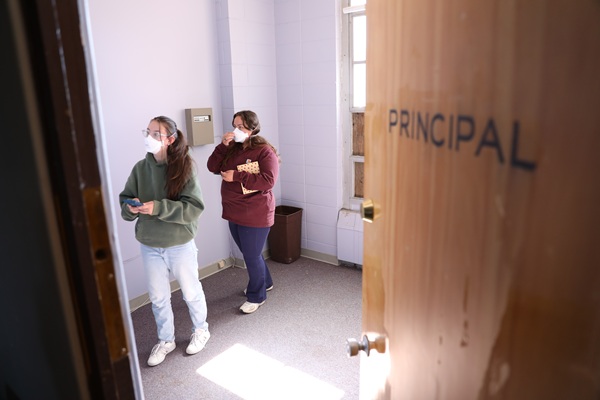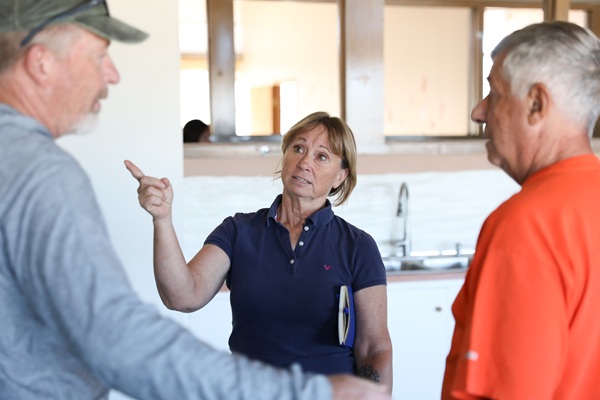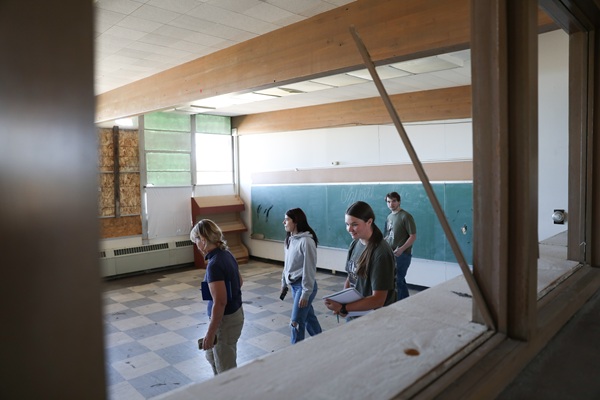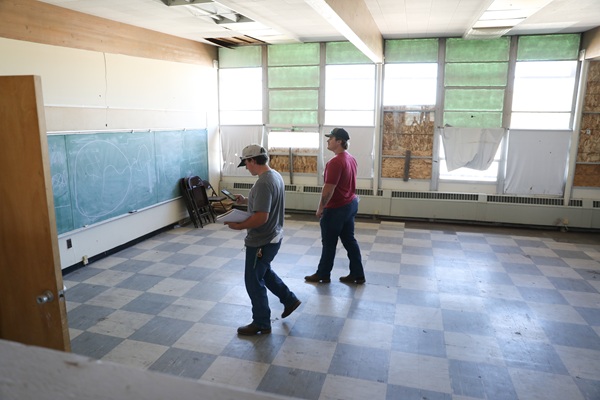Montana Technological University students collaborate on Blaine School Brownfields project
A shuttered school is the focus of a new partnership between Montana Technological University, the Town of Walkerville, the Hungry Hill Center for Art, Education, and Outreach, Montana Department of Environmental Quality, and Headwaters Resource Conservation and Development. The partnership is made possible through a contract between Montana Tech, Kansas State University and the Environmental Protection Agency for Montana Tech to assist landowners in redevelopment of impacted lands, and EPA Brownfields assessment and cleanup grants that have been awarded to Montana Department of Environmental Quality and Headwaters Resource Conservation and Development.

The Blaine School, built in 1959, was shuttered and transferred to the Town of Walkerville in 1984 after enrollment in Butte schools declined. At one time, the Montana Standard noted, the 12,000-foot structure housed a kitchen, an office, a gymnasium, classrooms, and offices.

Walkerville Mayor John Ries remembers the town renting out the space as an event center in decades past. It has more recently been used by the Air Force and law enforcement for training events. Without funding for maintenance, the space fell into disrepair and became a target for vandals.

“We couldn’t afford to heat the building because of the inadequate heating system in the boiler,” Ries said. “So, we just shut it down. The outside foundation is solid, but all the piers were on dirt in the middle. When they turned off the heat, I think that’s when the floors swelled; the gym got a nice hump in it.”
Ries sees potential in the building.

“The Town of Walkerville is exploring partnering in the project to use the renovated gym space for pickle ball, community meetings and events, wedding receptions, and staging and shelter in case of emergency,” Ries said.
The Hungry Hill Center for Art, Education, and Outreach believes the space could be a great place to teach classes and extend its reach.
“It’s time we turn it back into something,” Hungry Hill Center for Art, Education, and Outreach Executive Director Michael Kujawa said.
But what is the cost to remediate the building, clean up the contaminants and make it a viable space? It easily could tally up to tens of thousands of dollars just to get an assessment.
That’s where the Montana Department of Environmental Quality and Headwaters Resource Conservation and Development come in. They both have Brownfields programs focused on turning environmental liabilities into economic drivers for communities.
“This is a great example of something that’s been sitting underutilized for a long time,” Montana DEQ Brownsfield Coordinator Jason Seyler said. “There are hopes and dreams to turn it into something useful, but let’s figure out what’s actually there because no one really knows.”
Problems like lead paint and asbestos can often be issues in old buildings like the Blaine School.
“Everybody assumes, it’s built in the 1950s, that it would be full of asbestos, but you don’t really know until you sample,” Seyler said. “Sometimes there is no insulation at all. Maybe there is no asbestos, or maybe it’s just floor tiles, you don’t really know until you actually go in with a certified asbestos inspector and start taking samples.”
Students from Dr. Robin Bullock’s Sustainable Waste Management class and Dr. David Gilkey’s Occupational Safety and Health Senior Design class will test for environmental and safety hazards. They will provide a preliminary assessment to the Montana DEQ and Headwaters Resource Conservation and Development. The assessments will be provided for free to the developer and community as well.
“We’re taking Montana Tech’s hands on curriculum, partnering with the community, and collaborating to help each other ,” Bullock said. "This project provides a great opportunity to teach students about waste management while also moving a community project forward."
Montana Tech students participating include Lucas Russell, Declan Curtis, Hayden Fallang, Madison Skeel, Kevin Hilmo, Abbie Finks, Mayah Lemke, Braydin Golden, Kodie Hoagland, Luke Andersen, and Ty Raiha.
“Hands-on is a powerful way to learn about solving real-world problems,” Gilkey said. “The Blaine school facility has environmental, health and safety hazards (EHS) that will require students to pull from their education at Tech and learn new approaches to solving problems. The OSH Team is excited and up for the challenge.”
The reports will be provided to the Town of Walkerville and Hungry Hill Center for Art, Education, and Outreach so that they can make a plan, potentially apply for grants, and hopefully revitalize the space.
“Over the past decade, Walkerville has attracted an incredible community of working artists and entrepreneurs—drawn by affordable homes, welcoming neighbors, and breathtaking views,” Headwaters Resource Conservation and Development Brownfields Manager Melissa Wanamaker said. “Through big ideas and sheer sweat equity, they’re reshaping the character and possibility of Butte’s oldest neighborhood. The creation of a vibrant, community-minded art and education center will build on this momentum—enhancing the visibility, collaboration, and success of Walkerville’s existing creative and entrepreneurial efforts. Reclaiming this long-vacant, blighted property will proudly declare that Walkerville is open for business.”